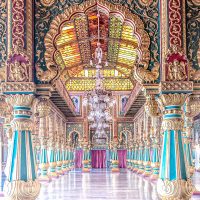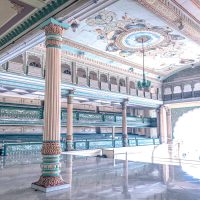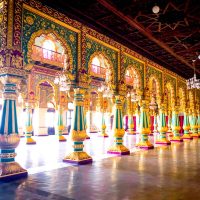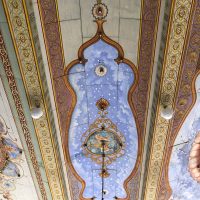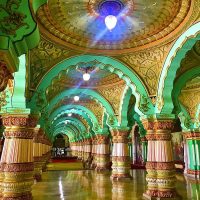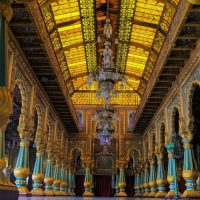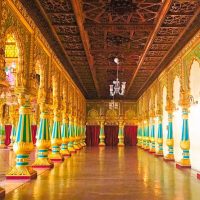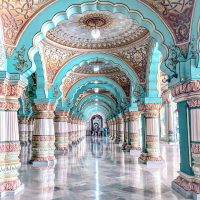About Mysore Palace-
Mysore Palace is also called Amba Vilas Palace and Mysore Aramane, located in the southern Indian state of Karnataka, is one of India’s grandest and impressive palaces. The majestic palace, situated in the heart of Mysore city, captures the attention of tourists from around the globe. Regarded as one of India’s top tourist attractions, after the Taj Mahal, drawing more than 6 million visitors a year.
History-
The Mysore Palace has a rich history. The origins of the palace date back to the 14th century, when it was initially constructed by the Wodeyars (also known as Wadiyars), the royal family of Mysore.
This grand palace was home to the Wadiyar family of Mysore for almost six hundred years, serving as their residence from 1350 to 1950. Yaduraya Wodeyar, the first ruler of the Mysore Kingdom, is believed to have built a palace in Puragiri (also referred to as the Old Fort) during his reign, which is thought to be the predecessor of the current palace. The palace has been destroyed and rebuilt several times over a period of six centuries.
At first, the palace was made of wood and served as a fortress, but unfortunately destroyed by lightning in 1638. After this incident, Kantirava Narasaraja Wodeyar reconstructed the palace with many new enhancements, including the addition of expansive pavilions and other structures.
In 1793 A.D., Tipu Sultan gained control of the Wodeyar Dynasty and decided to demolish and reconstruct the palace. After Tipu Sultan’s death in 1799, Krishnaraja Wodeyar III took control of the palace and renovated it in the Hindu architectural style.
Tragically, a fire broke out during the wedding of Princess Jayalakshmmanni in 1897 and completely destroyed the palace. However, Maharani Kempananjammanni Devi and her son Maharaja Krishnaraja Wodeyar IV have made the decision to rebuilding the palace.
During 1940, several modifications were carried out to enhance the structure of the palace, the Public Darbar Hall was one of them. One area of the Mysore Palace is still home to the royal family’s descendants while the majority of the palace has been taken over by the state and transformed into a museum.
Architecture-
The palace is a three-story Indo-Saracenic building which was constructed between 1897-1912 and wonderfully crafted square towers at the cardinal points that are covered in domes. In addition, the palace includes a three-story stone building with marble domes, and an impressive five-story tower that stands at a height of 145-feet.
The palace’s interiors are adorned with exquisite Czechoslovakian chandeliers, intricately carved doors, ceilings with stained glass, glistening glazed flooring tiles, and a rich collection of artwork from various parts of the world. Every room in the palace showcases opulent and alluring interiors.
The splendid exterior of this magnificent structure is embellished with two grand durbar halls, numerous arches, canopies, columns, and charming bay windows. The palace is surrounded by a vast garden. Above the central arch, there is an enchanting sculptural representation of Gajalakshmi, the goddess of wealth, accompanied by two elephants. Alongside the three entrances on the eastern, southern, and western sides, the palace also boasts several hidden tunnels, adding an element of mystery to its design.
There is also a group of temples at the palace, built from the 14th to the 20th century. The entrance gate and arch hold the emblem and coat of arms of the kingdom of Mysore, around which the kingdom’s motto is written in Sanskrit : “न बिभॆति कदाचन” (never terrified).
Mysore Palace: Today-
Presently, the administration of Mysore Palace is managed by the Government of Karnataka, while it still holds its prestigious status as the official residence of the Maharajas of Mysore. The magnificent structure protects numerous priceless relics of the Wodeyars, including trinkets, jewellery, regal attire, and paintings. Even though the palace is accessible to the general public, the former royal family still resides in a portion of it.
Mysore Palace Dussehra Celebrations-
Vijaya Dashami (Dussera) is the major festival that is celebrated every year. The Mysore Palace hosts the renowned Mysore Dussera Festival. Throughout this grand event, the palace grounds are transformed into stages where renowned artists showcase their talents.
The event lasts for around ten days, and on the tenth day, Dashami, an elephant parade with elaborate decorations leaves from the grounds of the palace. During Dussehra, the entire region is decorated to look like a wedding, drawing tourists from all over the world. The event is attended by members of the royal family as well as distinguished guests. On the auspicious occasion of Mahanavami, the ninth day of the festival, the royal sword, also known as the “Pattada Katti,” is taken on a procession throughout the city.
Mysore Palace Light and Sound Show-
One of the main attractions at the Mysore Palace is a spectacular light and sound show that runs every night, except Sundays and official holidays. This entire show beautifully presents the rich cultural legacy, historical significance, and traditional customs spanning over 600 years of the Wodeyar Dynasty.
Duration: 45 minutes
Timings: 7.00 pm to 08.00 pm; all days except Sundays and public holidays
Tickets: ₹ 70 for adults; ₹ 30 for kids above 7 years and below 12 years
Mysore Palace Illumination-
The Mysore Palace is illuminated in the evening on Sundays and public holidays, as well as during the 10-day Dasara celebrations. From Monday to Saturday, visitors can enjoy the visual splendor for five minutes after the light and sound show. The palace is truly impressive because it uses a total of 97,000 electric bulbs for illumination.
Timings: Sundays, public holidays, and during Dasara – 7:00 pm to 7:45 pm
Weekdays – 7:40 pm to 7:45 pm
Tickets: Not required
Mysore Palace Timings- Monday to Sunday: 10am to 5:30pm
Mysore Palace Attractions-
There is a fascinating array of things to see in and around Mysore Palace, each of which testifies to the wealth and grandeur of the Kingdom of Mysore. The top things to see in Mysore Palace include:
- Main Entrance and Old Palace Model of Mysuru Palace
- The Dolls’ Pavilion – Display of Dolls during Dasara Festivities.
- Elephant Gate / Ane Bagilu
- Goddess Chamundi
- Golden Throne
- Painting of Dasara Procession – Dasara Parade – Cannons & St. Philomena’s
- Painting of Dasara Procession – Dasara Parade – Signalman & Infantry
- Kalyana Mantap / Marriage Pavilion
- Portrait Gallery – Many valuable paintings & Photographs of the Royal Family are exhibited
- Casket Room
- Painting of Durga Puja during Dasara Procession
- Painting of The Maharaja during Dasara Procession
- Wrestling Courtyard
- Royal Furniture
- Public Durbar Hall
- The Wadiyar Dynasty
- Swan Centrepiece
- Hallway of Doors
- Private Durbar – Amba Vilas – Place where king and his closet advisers would meet to discuss the affairs of state View of the illuminated Mysuru Palace.
- Temples (Sri Lakshmi Ramana Swami Temple, Kodi Bhairava Swamy Temple, Sri Shweta Varahaswamy Temple, Sri Trinayaneshvara Swami Temple, Sri Prasanna Krishnaswamy temple, Kille Venkatramana Swamy Temple, Sri Bhuvaneshwari Temple, Sri Gayatri Temple)inside Mysuru Palace Fort
How to Reach Mysore Palace- Mysore is one of the more well-connected cities in Karnataka and is accessible through road, rail and air.
By Air – Mysore has its own airport, however it is not fully operational and does not link to all major cities. Therefore, travellers can reach Mysore via the Bangalore airport (170 km away). From there, one can hire a private taxi or use public transportation, such as a bus, to get to other areas of Mysore.
By Train – Mysore Junction, (also known as Mysuru Junction) is located along the Mysore-Bangalore railway line and offers both short- and long-distance service to many destinations, including Chennai, Delhi, and Mangalore. At the train station, travellers can easily access public transportation like buses and rickshaws to get where they’re going.
By Road- You can also get to Mysore by bus from Kempegowda Bus Station, which is close to the Bangalore City Railway Station. The Mysore city bus stand is right behind the Mysore Palace. Tickets are easily available at the bus station ticket counters.



